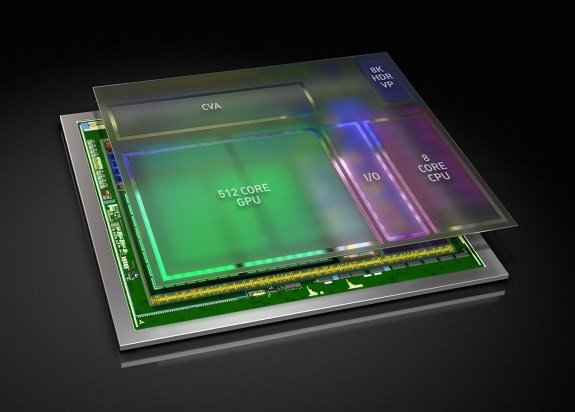The new SoC features 8 custom ARM64 CPU cores, 512 Volta GPU based graphics cores, a new computer vision accelerator, dual 8K HDR video processors and support for ASIL C Functional Safety (one level higher than the Drive PX 2).
NVIDIA says a single Xavier SoC will trump the current dual-Parker based Drive PX 2 in terms of performance, power efficiency and size. Xavier promises a score of 160 in the SPECint integer performance test, about 33 percent more than a Drive PX 2. Furthermore, Xavier's has a TDP of just 20W, four times lower than Xavier, while also requiring significantly less space.
Samples will ship to car makers and suppliers in Q4 2017.
At the inaugural GPU Technology Conference Europe, NVIDIA CEO Jen-Hsun Huang today unveiled Xavier, our all-new AI supercomputer, designed for use in self-driving cars.
“This is the greatest SoC endeavor I have ever known, and we have been building chips for a very long time,” Huang said to the conference’s 1,600 attendees.
Xavier is a complete system-on-chip (SoC), integrating a new GPU architecture called Volta, a custom 8 core CPU architecture, and a new computer vision accelerator. The processor will deliver 20 TOPS (trillion operations per second) of performance, while consuming only 20 watts of power. As the brain of a self-driving car, Xavier is designed to be compliant with critical automotive standards, such as the ISO 26262 functional safety specification.
Packed with 7 billion transistors, and manufactured using cutting-edge 16nm FinFET process technology, a single Xavier AI processor will be able to replace today’s DRIVE PX 2 configured with dual mobile SoCs and dual discrete GPUs — at a fraction of the power consumption.
Because autonomous driving is an incredibly compute-intense process, the need for an efficient AI processor is paramount. Xavier will bring self-driving car technology to automakers, tier 1 suppliers, startups and R&D organizations that are building autonomous vehicles, whether cars, trucks, shuttles or taxis.
Xavier samples will be available the fourth quarter of 2017 to automakers, tier 1 suppliers, startups and research institutions who are developing self-driving cars.

NVIDIA CEO Jen-Hsun Huang also talked about DriveWorks, a software development kit for self-driving cars. The first alpha release of this software is expected to be released to early partners in October.
Huang detailed the Alpha 1 release of our DriveWorks software, which incorporates a number of new modules, including support for free space detection — which helps self-driving cars determine where it’s safe for cars to drive; distance detection; lane detection; and 3D bounding boxes, which determine the size and shape of objects around the car.